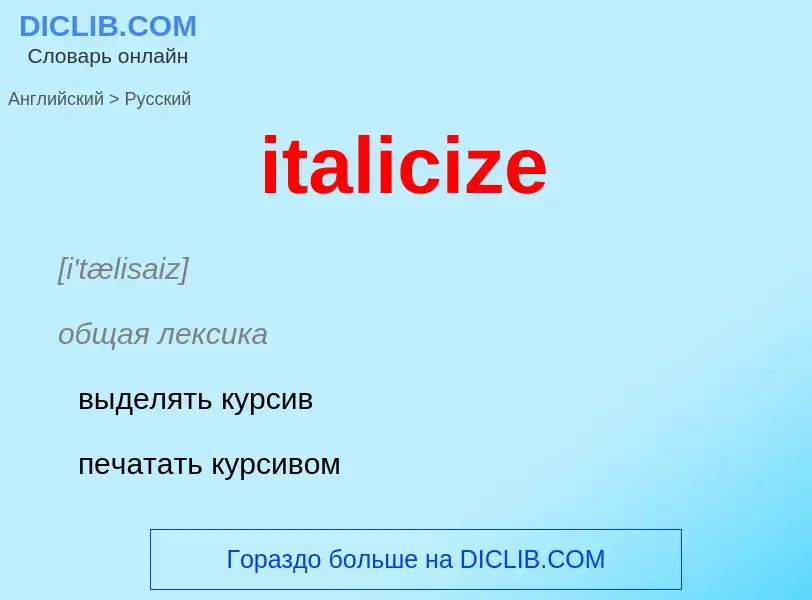Translation and analysis of words by ChatGPT artificial intelligence
On this page you can get a detailed analysis of a word or phrase, produced by the best artificial intelligence technology to date:
- how the word is used
- frequency of use
- it is used more often in oral or written speech
- word translation options
- usage examples (several phrases with translation)
- etymology
italicize - translation to russian
[i'tælisaiz]
общая лексика
выделять курсив
печатать курсивом
глагол
общая лексика
выделять курсивом
подчёркивать
выделять (в рукописи)
выделять
усиливать (в речи)
подчеркивать (в рукописи)
выделять подчеркиванием
подчеркивать, усиливать
Wikipedia

In typography, italic type is a cursive font based on a stylised form of calligraphic handwriting. Along with blackletter and roman type, it served as one of the major typefaces in the history of Western typography.
Owing to the influence from calligraphy, italics normally slant slightly to the right, like this. Different glyph shapes from roman type are usually used – another influence from calligraphy – and upper-case letters may have swashes, flourishes inspired by ornate calligraphy.
Historically, italics were a distinct style of type used entirely separately from roman type, but they have come to be used in conjunction—most fonts now come with a roman type and an italic type. In this usage, italics are a way to emphasise key points in a printed text, to identify many types of creative works, to cite foreign words or phrases, or, when quoting a speaker, a way to show which words they stressed. One manual of English usage described italics as "the print equivalent of underlining"; in other words, underscore in a manuscript directs a typesetter to use italic.
In fonts which do not have true italics, oblique type may be used instead. The difference between true italics and oblique type is that true italics have some letterforms different from the roman type, but in oblique type letters are just slanted without changing the roman type form.
The name comes from the fact that calligraphy-inspired typefaces were first designed in Italy, to replace documents traditionally written in a handwriting style called chancery hand. Aldus Manutius and Ludovico Arrighi (both between the 15th and 16th centuries) were the main type designers involved in this process at the time.





![Figgins]] foundry of London. The typeface is an example of the increasingly attention-grabbing, bold and dramatic fonts becoming popular in British display typography in the early nineteenth century. Figgins]] foundry of London. The typeface is an example of the increasingly attention-grabbing, bold and dramatic fonts becoming popular in British display typography in the early nineteenth century.](https://commons.wikimedia.org/wiki/Special:FilePath/Figgins Backslant.jpg?width=200)
![A page from La Operina by [[Ludovico Vicentino degli Arrighi]], showing the chancery writing style. A page from La Operina by [[Ludovico Vicentino degli Arrighi]], showing the chancery writing style.](https://commons.wikimedia.org/wiki/Special:FilePath/La Operina Arrighi 0039.jpg?width=200)

![Niccoli's]] cursive script, which developed into Italic type. Niccoli's]] cursive script, which developed into Italic type.](https://commons.wikimedia.org/wiki/Special:FilePath/Niccolo de Niccoli italic handwriting.jpg?width=200)
![access-date=17 August 2015}}</ref> [[Seravek]], a modern humanist family, has a more informal italic in the style of handwriting. access-date=17 August 2015}}</ref> [[Seravek]], a modern humanist family, has a more informal italic in the style of handwriting.](https://commons.wikimedia.org/wiki/Special:FilePath/Sans-serif italics.png?width=200)

.jpg?width=200)
